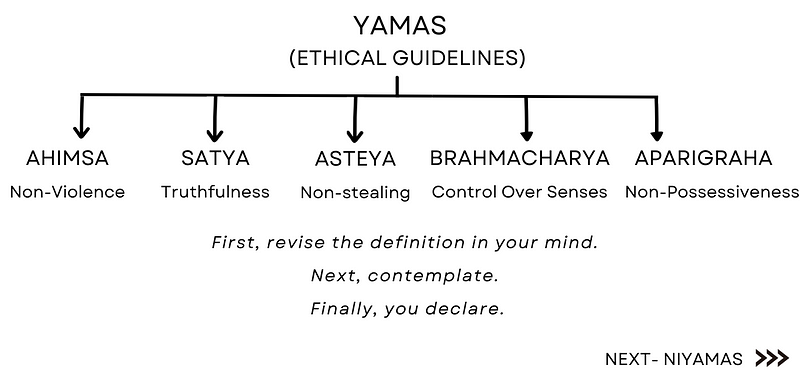Yoga: Beyond Exercise - Embracing the 8-Fold Path of Self-Discovery
Written on
Chapter 1: The Essence of Yoga
Yoga originated as a sacred practice designed to elevate the mind, body, and spirit. However, over the years, its essence has shifted significantly.
The sage Maharishi Patanjali, revered as the "father of yoga," systematized this philosophy in the Yoga Darshan, a seminal text on yoga. He provided a framework for achieving comprehensive physical, mental, and spiritual wellness. Initially, yoga was a spiritual discipline, evolving later into a physical exercise regimen.
Traditionally, yoga encompassed more than just physical stretches; it represented a holistic approach aimed at the complete development of an individual. This included character enhancement, social conduct, breath control, meditation, and methods for mental and physical growth.

One of the significant benefits of yoga is reaching a state known as Chitta Vritti Nirodha. In this context, "Chitta" refers to the mind or consciousness, while "Vritti" denotes the constant fluctuations within that consciousness. "Nirodha" signifies the cessation or calming of these fluctuations. Collectively, this Sanskrit term translates to "stopping the disturbances of the mind."
The term "yoga" derives from the Sanskrit word "yuj," which means "union." This union signifies the connection between the individual self (Atman) and the universal consciousness (Brahman).
In the 20th century, yoga's journey to the West primarily highlighted its physical postures. This transition led to a focus on physical fitness rather than spiritual evolution. While the physical advantages of yoga are evident, this shift has resulted in a departure from its original principles.
Modern trends like beer yoga, goat yoga, and even naked yoga dilute the true essence of yoga, prioritizing novelty over self-awareness and spiritual growth. Despite these trends, there is a burgeoning movement aimed at reclaiming the authentic spirit of yoga. Many practitioners stress the importance of a holistic approach that incorporates meditation, breathwork, and ethical principles.
To contribute to this movement, this article aims to explore the foundational teachings of yoga. At its core, Patanjali's philosophy is encapsulated in Ashtanga Yoga, which translates to the "eight limbs of yoga."
These limbs are:
- Yama (Ethical Guidelines)
- Niyama (Self-Discipline)
- Asana (Physical Postures)
- Pranayama (Breath Control)
- Pratyahara (Sense Withdrawal)
- Dharana (Concentration)
- Dhyana (Meditation)
- Samadhi (Absorption)
In the sections that follow, we will examine each step in detail.
Video Description: In this video, explore how the Noble Eight-fold Path relates to your yoga practice and its significance in spiritual growth.
Chapter 2: The Eight Limbs of Yoga
Video Description: This episode discusses whether yoga counts as exercise, delving into its physical and spiritual benefits.
Section 2.1: Yama (Ethical Guidelines)
Yama encompasses ethical principles governing our interactions with the world. In yoga practice, it is the first aspect to consider.
There are five Yamas, and for each, you should:
- Understand its definition.
- Reflect on your daily actions and identify any deviations from these principles.
- Set intentions to improve in the future.
This continuous practice evolves throughout your daily life. It's normal to encounter setbacks; embodying all the Yamas is a gradual journey.
The five Yamas include:
- Ahimsa (Non-violence) - This principle extends beyond physical harm, promoting kindness and compassion towards all beings, including oneself.
- Satya (Truthfulness) - Being honest with yourself and others, aligning your thoughts, words, and actions.
- Asteya (Non-stealing) - Fairness in thoughts and actions, avoiding taking what is not yours.
- Brahmacharya (Control Over Senses) - Resisting over-indulgence and mastering your desires and emotions.
- Aparigraha (Non-Possessiveness) - Embracing a balanced approach towards possessions, fostering freedom from stress.

Section 2.2: Niyama (Self-Discipline)
Niyama emphasizes self-discipline and habits that foster well-being. These practices should be contemplated alongside Yamas to deepen your understanding.
The five Niyamas are:
- Saucha (Cleanliness) - Maintaining both physical and mental purity.
- Santosha (Contentment) - Finding happiness within regardless of external situations.
- Tapas (Perseverance) - Committing to self-discipline and sacrifice.
- Swadhyaya (Self-Study) - Engaging in reading and learning for personal growth.
- Ishvarapranidhana (Surrender to a Higher Power) - Embracing humility and recognizing a greater plan at work.

Section 2.3: Asana (Posture)
Following the contemplation of Yama and Niyama, yoga practice begins with Asana. The term refers to "posture" and signifies the importance of a stable and comfortable sitting position.
Video Description: This video illustrates how to properly perform various yoga postures and their significance in practice.
The aim is to achieve a posture that allows for prolonged stability without discomfort, facilitating deeper states of meditation.
Section 2.4: Pranayama (Breath Control)
Patanjali identifies Pranayama as the fourth limb of Ashtanga Yoga, focusing on breath regulation in a relaxed state. This practice enhances concentration, vital for the subsequent step, Dharana.
Section 2.5: Pratyahara (Sense Withdrawal)
Pratyahara represents the withdrawal of the senses, allowing for greater focus and control over one's experiences. It is a crucial step towards achieving deeper states of meditation.
Section 2.6: Dharana (Concentration)
Dharana involves directing the mind's attention to a single point or object, paving the way for sustained meditation.
Section 2.7: Dhyana (Meditation)
Meditation is the uninterrupted flow of focus on a chosen object, nurturing deeper states of awareness and control over the mind.
Section 2.8: Samadhi (Absorption)
Samadhi is the ultimate state of absorption during meditation, where the practitioner experiences unity with the divine essence.
Conclusion
In an increasingly materialistic world, yoga serves as a transformative practice that elevates every aspect of our lives. It nurtures ethical living, mental clarity, and deeper self-awareness.
To truly grasp the essence of yoga, one must delve into the philosophy of universal consciousness (Brahman), the self (Atman), and the interconnectedness of all existence (Prakriti). The Vedic tradition encourages questioning and reasoning, offering a profound exploration of truth.
For anyone interested in this journey, feel free to reach out with questions or insights in the comments below!